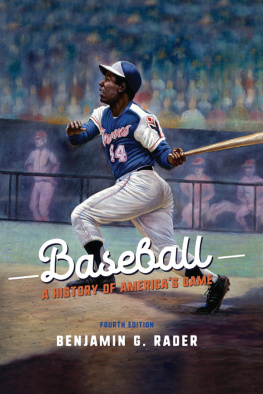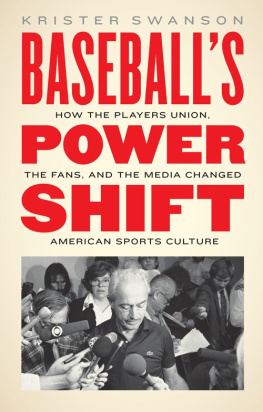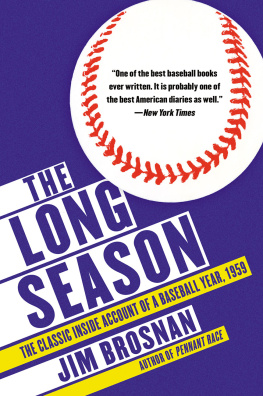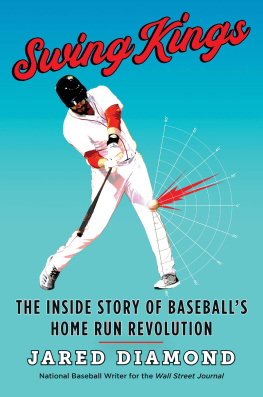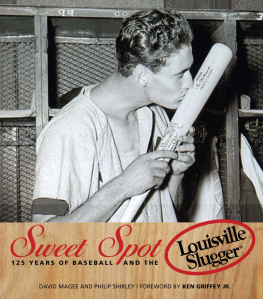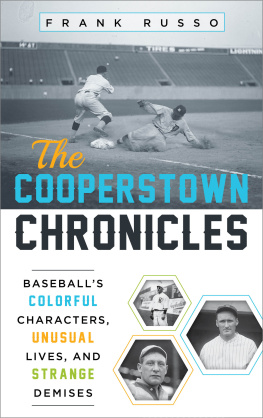Acknowledgments
Let me again acknowledge first and foremost those who introduced me to ball playing. They were my schoolmates on the red-clay playgrounds of one-room schools in the southern Missouri Ozarks. During recess, girls and boys ranging in age from six or seven to fourteen or so gathered for a brisk game of work-up. In work-up, players start in the outfield, working their way up with each out, from the outfield to third base, from third base to shortstop, and so on until finally getting an opportunity to hit. Players remain at bat as long as they do not make an out, but because in our game only two or three people were at bat, even a good hitter could become the victim of a force out. A batter who has been retired must return to the outfield. Depending on the size and age of the players, we sometimes permitted crossouts as well. In crossout, a player can put the runner out by throwing the ball between the runner and the next base. At the time, I had no idea that our schoolyard game was similar to a game from which modern baseball evolved or that one day I would write a history of the sport.
During this era of my life as well as in high school, two people in particular stimulated and sustained my interest in baseball. First was my brother Mike, who is a year younger than I am. On our isolated farm, my brother and I talked endlessly about the game, played catch at every spare moment, played on an assortment of teams together, and, whenever we could, coerced our four younger siblings into practicing baseball or softball. The other was Harry Caray, the voice of the St. Louis Cardinals. I spent many hours listening to Caray's vivid accounts of the Cardinals on radio station KWPM in West Plains, Missouri. In the meantime, I became an avid reader of the daily sports page of the Springfield (Missouri) News-Leader. An occasional delight (when I could afford it) was reading The Sporting News, where I learned about the intricate world of minor league baseball as well as about the big leagues. Since then many others (acknowledged in previous editions) have aided me in writing about America's game.
Several people have contributed more directly to this edition. I particularly thank Kent Krause, who repeatedly offered me keen advice on all aspects of recent baseball history. (May we continue our annual outing to witness the play of the Lincoln, Nebraska, Saltdogs?) In addition, I benefited from the critical readings offered by Russ Crawford, Ken Gatter, Steven Gietschier, John McManus, Daniel Nathan, David Ogden, Steven Riess, and Stephen Tripp. Thanks to Lee Lowenfish for bibliographical guidance; to Daniel Nassett for advice that led to the re-conceptualization of the final chapter; to John Comer for being a friend and a sometime baseball consultant; to Kenneth Winkle for longtime assistance on baseball and many other matters; to Vanessa Gorman for friendship and serving as my word processing guru; and superseding all others, Barbara Rader for things both small and large.
BENJAMIN G. RADER is James L. Sellers Professor Emeritus of History at the University of Nebraska, Lincoln, and the coauthor of American Sports: From the Age of Folk Games to the Age of Televised Sports, Seventh Edition.
The University of Illinois Press
is a founding member of the
Association of American University Presses.
____________________________________
University of Illinois Press
1325 South Oak Street
Champaign, IL 618206903
www.press.uillinois.edu
Bibliographical Essay
GENERAL
As befits the subject, baseball's literature is immense. For those seeking more complete bibliographies than this one, see Myron J. Smith, comp., Baseball: A Comprehensive Bibliography (1986, 1998), and Baseball Bibliography, 4 vols. (2005). For a current guide to baseball's extensive historical literature, consult NINE: A Journal of Baseball History and Culture, which also contains valuable articles on the history of the game. The Web has become the easiest way to access and search a wide range of baseball subjects. See, for example, the SABR Web site, www.sabr.org. Libraries especially notable for their holdings in baseball history include the Baseball Hall of Fame and Museum Library in Cooperstown, New York, the New York Public Library, and the Library of Congress, but students of the game may find important collections in their local libraries as well. For baseball historiography, see Larry R. Gerlach, Not Quite Ready for Prime Time: Baseball History, 19831993, Journal of Sport History 21.2 (Summer 1994), Warren Goldstein's delightful, Thirty Years of Baseball History: A Player's Notes, Reviews in American History 38.4 (Dec. 2010), and Richard Peterson's Extra Innings: Writing Baseball (2001). There are many worthwhile though sometimes pretentious books and essays treating the cultural meaning of baseball. Sample among others the writings of Roger Angell, Thomas Boswell, James T. Farrell, Peter Gammons, A. Bartlett Giamatti, Stephen Jay Gould, Allen Guttmann, David McGimpsey, Michael Novak, Richard Peterson, Jules Tygiel, and George Will.
Recently Web sites such as www.mlb.com, www.baseball-reference.com, www.baseball-almanac.com, and www.seamheads.com have mostly supplanted earlier hefty tomes as compendiums of statistics as well essays about the game, but both John Thorn, Total Baseball (2004) and Gary Gillette and Pete Palmer, eds., The ESPN Baseball Encyclopedia, 5th ed. (2008), remain extraordinarily useful reference works. Those intrigued by the use of statistics in baseball history should begin with the extensive writings and statistics generated by Bill James, especially The Bill James Historical Baseball Abstract (1988, 2001). While not a sophisticated statistician, James writes with a flair and has not only effectively challenged some of the game's hallowed conventions, but he also invented the term sabermetrics. The term honors the Society for American Baseball Research (SABR), organized in 1971, and describes what is done by those who use social science methods to research baseball as it is played. (For what is sometimes described as the analytics revolution in baseball, see the final paragraph of this essay.) For a history of how baseball statistics have developed, see Alan Schwarz, The Numbers Game: Baseball's Lifelong Fascination with Statistics (2004). Much of Robert Kemp Adair's The Physics of Baseball, 3rd edition (2002) is accessible to the untutored.
Except for Albert Spalding's America's National Game (1911, 1992), the republished Alfred H. Spink, The National Game (2000), and Francis C. Richter, Richter's History and Records of Baseball (1914), serious general histories of baseball are rather recent. Among the more successful one-volume histories consider James, The Bill James Historical Abstract, previously cited; Leonard Koppett, Koppett's Concise History of Major League Baseball (1998); Fred Lieb, The Baseball Story (1950); Charles Alexander, Our Game (1991); and Joel Zoss and John Bowman, Diamonds in the Rough (1989). For scholarly essays, see John Dreifort, ed., Baseball History Outside the Lines: A Reader (2001); Jules Tygiel, Past Time: Baseball as History (2000); Donald G. Kyle and Robert B. Fairbanks, eds. Baseball in America & America in Baseball (2008), that includes my take on Ty Cobb; John B. Wiseman, ed., Joy in Mudville: Essays on Baseball and American Life (2009); and Tristram Potter Coffin's The Old Ball Game (1971), a neglected but pioneering book on baseball folklore and fiction.
Baseball has three multivolume histories. Exceptionally rich in detail and understanding of the organizational side of the game's history are Harold Seymour's

